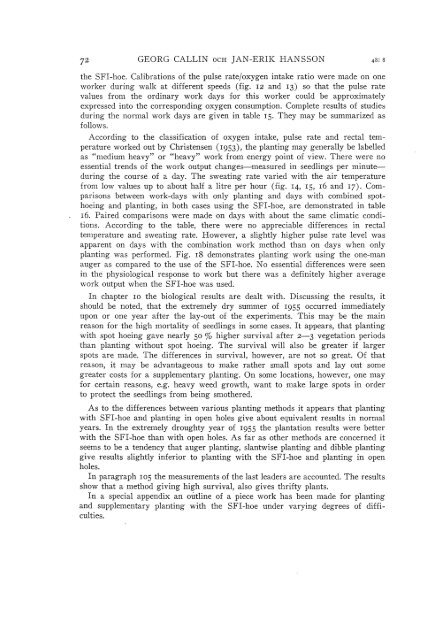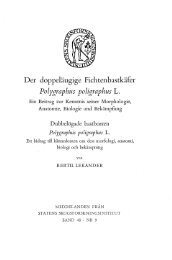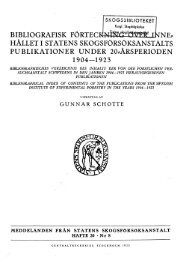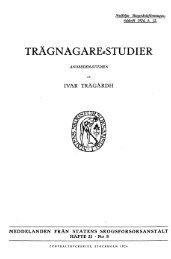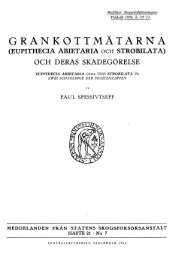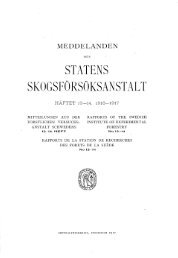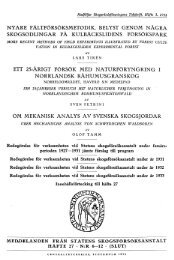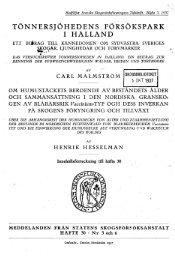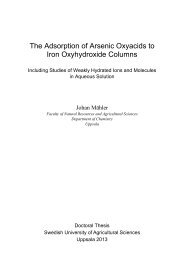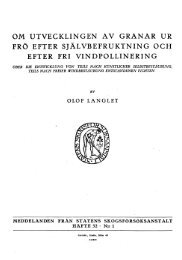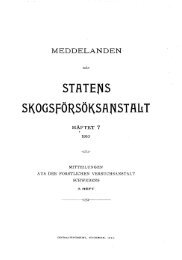Plantering av tall och gran - Epsilon Open Archive
Plantering av tall och gran - Epsilon Open Archive
Plantering av tall och gran - Epsilon Open Archive
Create successful ePaper yourself
Turn your PDF publications into a flip-book with our unique Google optimized e-Paper software.
72<br />
GEORG CALLIN ocH JAN-ERIK HANSSON<br />
the SFI-hoe. Calibrations of the pulse rate/oxygen intake ratio were made on one<br />
worker during walk at different speeds (fig. 12 and 13) so that the pulse rate<br />
values from the ordinary work days for this worker could be approximately<br />
expressed into the corresponding oxygen consumption. Complete results of studies<br />
during the normal work days are given in table 1S. They may be summadzed as<br />
follows.<br />
According to the classification of oxygen intake, pulse rate and rectal temperature<br />
worked out by Christensen (19S3), the planting maygenerally be labelled<br />
as "medium he<strong>av</strong>y" or "he<strong>av</strong>y" work from energy point of view. There were no<br />
essential trends of the work output changes-measured in seedlings per minuteduring<br />
the course of a day. The sweating rate varied with the air temperature<br />
from low values up to about half a litre per hour (fig. 14, 1s, 16 and 17). Comparisons<br />
between work-days with only planting and days with combined spothoeing<br />
and planting, in both cases using the SFI-hoe, are demonstrated in table<br />
16. Paired comparisons were made on days with about the same elirnatic conditions.<br />
According to the table, there were no appreciable differences in rectal<br />
temperature and sweating rate. However, a slightly higher pulse rate leve! was<br />
apparent on days with the combination work metl1od than on days when only<br />
planting. was performed. Fig. 18 demonstrates planting work using the one-man<br />
auger as campared to the use of the SFI-hoe. N o essen tia! differences were seen<br />
in the physiological response to work but there was a definitely higher <strong>av</strong>erage<br />
work output when the SFI-hoe was used.<br />
In chapter 10 the biological results are dealt with. Discussing the results, it<br />
should be noted, that the extremely dry summer of 19SS occurred immediately<br />
upon or one year after the lay-out of the experiments. This may be the main<br />
reason for the high mortality of seedlings in some cases. It appears, that planting<br />
with spot hoeing g<strong>av</strong>e nearly so % higher survival after 2-3 vegetation periods<br />
than planting without spat hoeing. The survival will also be greater if larger<br />
spats are made. The differences in survival, however, are not so great. Of that<br />
reason, it may be advantageous to make rather small spots and lay out some<br />
greater costs for a supplementary planting. On some locations, however, one may<br />
for certain reasons, e.g. he<strong>av</strong>y weed growth, want to make !arge spots in order<br />
to proteet the seedlings from being smothered.<br />
As to the differences between various planting methods it appears that planting<br />
with SFI-hoe and planting in open holes give about equivalent results in normal<br />
years. In the extremely droughty year of 19SS the plantation results were better<br />
with the SFI-hoe than with open hales. As far as other metl1ods are cancerned it<br />
seems to be a tendency that auger planting, slantwise planting and dibble planting<br />
give results slightly inferior to planting with the SFI-hoe and planting in open<br />
hales.<br />
In paragraph ros the measurements of the last leaders are accounted. The results<br />
show that a method giving high survival, also gives thrifty plants.<br />
In a special appendix an outline of a piece work has been made for planting<br />
and supplementary planting with the SFI-hoe under varying degrees of difficulties.


